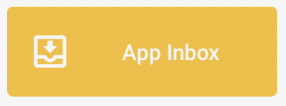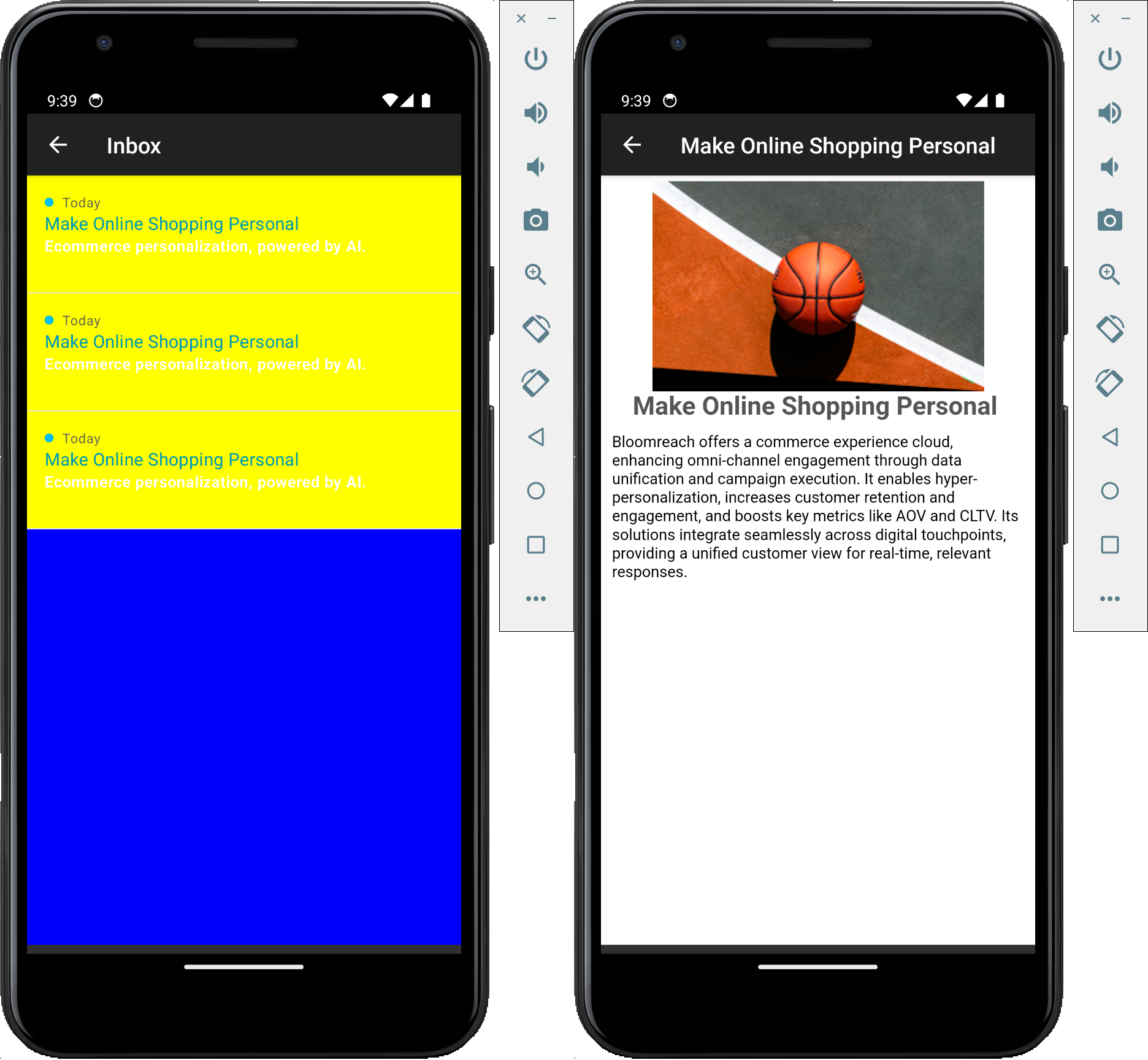App Inbox
Add a message inbox to your app using the Flutter SDK
The App Inbox feature creates a mobile communication channel that lives directly in your app. This inbox can receive messages from marketing campaigns and stores mobile push notifications for a set time period.
You can configure the inbox to receive messages from multiple projects by setting the applicationId parameter during setup.
The SDK can only retrieve App Inbox messages when the current app user has a customer profile with a hard ID. Without this identification, the feature won't work.
Refer to the App Inbox documentation for information on creating and sending App Inbox messages in the Engagement web app.
App Inbox is a separate module that can be enabled on request in your Engagement account by your Bloomreach CSM.
Integrate the App Inbox
You can integrate the App Inbox through a button provided by the SDK, which opens the App Inbox messages list view.

You can then add the button anywhere in your app. For example:
ListTile(
title: const Text('App Inbox'),
subtitle: Row(
children: const [
SizedBox(width: 150, height: 50, child: AppInboxProvider()),
]
)
),
The App Inbox button registers a click action to show an App Inbox list screen.
That's all that's required to integrate the App Inbox. Optionally, you can customize it to your needs.
See home.dart for a reference implementation.
Default App Inbox behavior
The SDK fetches and displays the App Inbox automatically as follows:
- Display a button to access the App Inbox messages list view (integration by developer).
- Display a messages list view. Display each item with:
- Flag indicating whether the message is read or unread.
- Delivery time in human-readable form (for example,
2 hours ago). - Single-lined title of the message (ended by '...' for longer values).
- Two-lined content of the message (ended by '...' for longer values).
- Squared image if the message contains any.
- Loading progress indicator of the list.
- Empty Inbox title and message in case there are no messages.
- Error title and description in case of an error loading the list
- Call
ExponeaPlugin().trackAppInboxOpenedwhen the user clicks on a list item and mark the message as read automatically. - Display a message detail view that contains:
- Large squared image (or a gray placeholder if the message doesn't contain an image).
- Delivery time in human-readable form (for example,
2 hours ago). - Full title of the message.
- Full content of the message.
- A button for each action in the message that opens a browser link or invokes a universal link. No button is displayed for an action that opens the current app.
- Call
ExponeaPlugin().trackAppInboxClickautomatically when the user clicks a button in the message detail view.

The behavior of
trackAppInboxOpenedandtrackAppInboxClickmay be affected by the tracking consent feature, which in enabled mode considers the requirement of explicit consent for tracking. Refer to Consent for details.
Customize App Inbox
Although the App Inbox works out of the box once the button has been integrated in your app, you may want to customize it to your app's requirements.
Localization
The SDK provides the following UI labels in English. You can modify these or add localized labels by defining customized strings.
For Android, add to your strings.xml files:
<string name="exponea_inbox_button">Inbox</string>
<string name="exponea_inbox_title">Inbox</string>
<string name="exponea_inbox_defaultTitle">Inbox message</string>
<string name="exponea_inbox_emptyTitle">Empty Inbox</string>
<string name="exponea_inbox_emptyMessage">You have no messages yet.</string>
<string name="exponea_inbox_errorTitle">Something went wrong :(</string>
<string name="exponea_inbox_errorMessage">We could not retrieve your messages.</string>
<string name="exponea_inbox_mainActionTitle">See more</string>
For iOS, add to your Localizable.string files:
"exponea.inbox.button" = "Inbox";
"exponea.inbox.title" = "AppInbox";
"exponea.inbox.loading" = "Loading messages...";
"exponea.inbox.emptyTitle" = "Empty Inbox";
"exponea.inbox.emptyMessage" = "You have no messages yet.";
"exponea.inbox.errorTitle" = "Something went wrong :(";
"exponea.inbox.errorMessage" = "We could not retrieve your messages.";
"exponea.inbox.defaultTitle" = "Message";
"exponea.inbox.mainActionTitle" = "See more";
Customize UI styles
The App Inbox screens are designed to satisfy most customers' needs. However, they may not fit the design of your application. You can customize colors and text styles through configuration.
_plugin.setAppInboxProvider(AppInboxStyle(
appInboxButton: SimpleButtonStyle(
// ButtonStyle
textOverride: 'text value',
textColor: 'color',
backgroundColor: 'color',
showIcon: true,
textSize: '12px',
enabled: true,
borderRadius: '5px',
textWeight: 'bold|normal|100..900'
),
detailView: DetailViewStyle(
title: TextViewStyle(
// TextViewStyle
visible: true,
textColor: 'color',
textSize: '12px',
textWeight: 'bold|normal|100..900',
textOverride: 'text'
),
content: TextViewStyle(...),
receivedTime: TextViewStyle(...),
image: ImageViewStyle(
// ImageViewStyle
visible: true,
backgroundColor: 'color'
),
button: SimpleButtonStyle(),
},
listView: ListScreenStyle(
emptyTitle: TextViewStyle(...),
emptyMessage: TextViewStyle(...),
errorTitle: TextViewStyle(...),
errorMessage: TextViewStyle(...),
progress: ProgressBarStyle(
// ProgressBarStyle
visible: true,
progressColor: 'color',
backgroundColor: 'color'
),
list: AppInboxListViewStyle(
backgroundColor: 'color',
item: AppInboxListItemStyle(
backgroundColor: 'color',
readFlag: ImageViewStyle(),
receivedTime: TextViewStyle(...),
title: TextViewStyle(...),
content: TextViewStyle(...),
image: ImageViewStyle(),
),
),
)
})
Supported colors formats:
- Short hex
#rgbor with alpha#rgba - Hex format
#rrggbbor#rrggbbaa - RGB format
rgb(255, 255, 255) - RGBA format
rgba(255, 255, 255, 1.0)orrgba(255 255 255 / 1.0) - ARGB format
argb(1.0, 255, 255, 255) - Name format
yellow(names has to be supported by Android/iOS platform)
Supported size formats:
- Pixels
12pxor12 - Scaleable Pixels
12sp - Density-independent Pixels
12dpor12dip - Points
12pt - Inches
12in - Millimeters
12mm
The iOS platform does not support DPI conversions and only accepts number values for size.
Supported text weight formats:
- 'normal' - normal/regular style on both platforms
- 'bold' - bold style on both platforms
- Number from
100to900- mainly usable on iOS. Limited support on Android (100-600 means 'normal'; 700-900 means 'bold')
You may register your own styling at any time - before SDK initialization or later in some of your screens. Every action in scope of the App Inbox uses currently registered styles. We recommend to register your styles configuration right before you initialize the SDK.
Android style rules
The style rules defined for the App Inbox UI components are listed below. You can override them in your styles.xml files.
<style name="Theme.AppInboxListActivity" parent="@style/Theme.AppCompat.NoActionBar">
<!-- Screen shows App Inbox list -->
<!-- This style is applied to 'android:theme' activity parameter -->
</style>
<style name="Theme.AppInboxDetailActivity" parent="@style/Theme.AppCompat.NoActionBar">
<!-- Screen shows App Inbox message detail -->
<!-- This style is applied to 'android:theme' activity parameter -->
</style>
<style name="AppInboxItemReceivedTime">
<!-- TextView shows delivery time in App Inbox list -->
<!-- This style is applied to 'style' parameter -->
</style>
<style name="AppInboxItemTitle">
<!-- TextView shows title in App Inbox list -->
<!-- This style is applied to 'style' parameter -->
</style>
<style name="AppInboxItemContent">
<!-- TextView shows message content in App Inbox list -->
<!-- This style is applied to 'style' parameter -->
</style>
<style name="AppInboxDetailReceivedTime">
<!-- TextView shows delivery time in message detail -->
<!-- This style is applied to 'style' parameter -->
</style>
<style name="AppInboxDetailTitle">
<!-- TextView shows title in message detail -->
<!-- This style is applied to 'style' parameter -->
</style>
<style name="AppInboxDetailContent">
<!-- TextView shows message content in message detail -->
<!-- This style is applied to 'style' parameter -->
</style>
<style name="Theme.AppInboxAppBarOverlay" parent="ThemeOverlay.AppCompat.Dark.ActionBar">
<!-- AppBarLayout is shown in both list and detail screens -->
<!-- This style is applied to 'android:theme' parameter -->
</style>
<style name="Theme.AppInboxAppBarPopupOverlay" parent="ThemeOverlay.AppCompat.Light">
<!-- Toolbar is shown inside AppBarLayout -->
<!-- This style is applied to 'app:popupTheme' parameter -->
</style>
<style name="AppInboxButton" parent="@style/Widget.AppCompat.Button">
<!-- Button opens App Inbox list screen -->
<!-- This style is applied to 'style' button parameter -->
</style>
<style name="AppInboxActionButton" parent="@style/Widget.AppCompat.Button">
<!-- Button invokes App Inbox message action in detail -->
<!-- This style is applied to 'style' parameter -->
</style>
<style name="AppInboxEmptyStatusTitle">
<!-- TextView shows title for App Inbox list empty state -->
<!-- This style is applied to 'style' parameter -->
</style>
<style name="AppInboxEmptyStatusMessage">
<!-- TextView shows message for App Inbox list empty state -->
<!-- This style is applied to 'style' parameter -->
</style>
<style name="AppInboxErrorStatusTitle">
<!-- TextView shows title for App Inbox list error state -->
<!-- This style is applied to 'style' parameter -->
</style>
<style name="AppInboxErrorStatusMessage">
<!-- TextView shows message for App Inbox list error state -->
<!-- This style is applied to 'style' parameter -->
</style>
<style name="AppInboxStatusLoading" parent="android:Widget.DeviceDefault.ProgressBar.Large">
<!-- ProgressBar shown for App Inbox list loading state -->
<!-- This style is applied to 'style' parameter -->
</style>
Customize UI Components
If use of the App Inbox button flow doesn't suit your needs, you can integrate the App Inbox List View through a widget provided by the SDK, which displays the App Inbox messages list. Also, you can use Detail view, once the user picks a message from the list to show.
App Inbox List View
The AppInboxListView implements all the data handling (fetching, displaying data, action listeners, etc.).
The methods ExponeaPlugin().trackAppInboxOpened and ExponeaPlugin().markAppInboxAsRead are called automatically when the user clicks on an item.
The click action for each item in the list triggers the onAppInboxItemClicked callback with AppInboxMessage as a parameter. You can then navigate the user to the page showing detail of that clicked message. For example:
AppInboxListView(
onAppInboxItemClicked: (AppInboxMessage message) {
Navigator.of(context).push(MaterialPageRoute(builder: (context) => AppInboxDetailPage(messageId: message.id)));
},
)
App Inbox Detail View
The AppInboxDetailView implements all the data handling (fetching, displaying data, action listeners, etc.).
The method ExponeaPlugin().trackAppInboxClick is called automatically when the user clicks on an action.
You can show detail of a message as a full-screen View. For example:
Scaffold(
appBar: AppBar(title: const Text('App inbox message')),
body: AppInboxDetailView(messageId: messageId),
);
App Inbox data API
The SDK provides methods to access App Inbox data directly without accessing the UI layer.
Fetch App Inbox
The App Inbox is assigned to an existing customer account (identified by a hard ID). Calling either of the following methods will clear the App Inbox:
ExponeaPlugin().identifyCustomerExponeaPlugin().anonymize
To prevent large data transfers on each fetch, the SDK stores the App Inbox locally and loads incrementally. The first fetch will transfer the entire App Inbox, but subsequent fetches will only transfer new messages.
The App Inbox assigned to the current customer can be fetched as follows:
var messages = await ExponeaPlugin().fetchAppInbox();
It's also possible to fetch a single message by its ID from the App Inbox as follows:
var message = await ExponeaPlugin().fetchAppInboxItem(messageId);
Fetching a single message triggers fetching the entire App Inbox (including incremental loading) but will retrieve the data from local storage if the App Inbox was fetched previously.
Mark message as read
Use the markAppInboxAsRead method, passing an App Inbox message object as argument, to mark the message as read:
var markedAsRead = ExponeaPlugin().markAppInboxAsRead(message);
Marking a message as read using the
markAppInboxAsReadmethod does not trigger a tracking event for opening the message. To track an opened message, you need to call theExponeaPlugin().trackAppInboxOpenedmethod).
Track App Inbox events manually
The SDK tracks App Inbox events automatically by default. In case of a custom implementation, it is the developers' responsibility to use the relevant tracking methods in the right places.
Track opened App Inbox message
Use the ExponeaPlugin().trackAppInboxOpened(MessageItem) method to track the opening of App Inbox messages.
The behavior of trackAppInboxOpened may be affected by the tracking consent feature, which, when enabled, requires explicit consent for tracking. Refer to Tracking consent for details.
If you want to ignore tracking consent, use ExponeaPlugin().trackAppInboxOpenedWithoutTrackingConsent instead. This method will track the event regardless of consent.
Track clicked App Inbox message action
Use the ExponeaPlugin().trackAppInboxClick(MessageItemAction, MessageItem) method to track action invocations in App Inbox messages.
The behavior of trackAppInboxClick may be affected by the tracking consent feature, which, when enabled, requires explicit consent for tracking. Refer to Tracking consent for details.
If you want to ignore tracking consent, use ExponeaPlugin().trackAppInboxClickWithoutTrackingConsent instead. This method will track the event regardless of consent.
Updated 3 months ago
